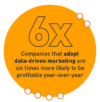In the complex world of business-to-business (B2B) marketing, establishing a strong brand and generating demand are crucial for growth. Brand-to-demand (B2D) marketing is a strategic approach that intertwines branding and demand generation activities to not only build brand credibility but also stimulate interest in a company’s products or services.
In the B2B sector, B2D is particularly relevant due to the often long and intricate buying cycles. Companies need to continually reinforce their brand to remain top of mind for their target audience while simultaneously driving demand to keep the sales pipeline full. B2D marketing provides a comprehensive strategy to balance these needs, making it a crucial part of any successful B2B marketing strategy.
The second article in this series explores the key elements of brand-to-demand marketing and how your B2B company can leverage them to drive success in today’s competitive market.
Key Elements of Brand-to-Demand Marketing

With a well-executed B2D strategy, your B2B company can create a brand that resonates with your audience while simultaneously driving demand for your products or services. Let’s review the key elements that make brand-to-demand marketing successful.
Key Element 1: Strong, Consistent Brand Identity
A strong, consistent brand identity is the backbone of any successful B2D strategy. It encompasses everything from your messaging to your visual identity, and is crucial in establishing authenticity, trust, and recognition with your audience.
Why Brand Identity is Important
 A powerful and consistent brand identity not only differentiates your business from competitors but also cultivates trust and stimulates customer demand. As confirmed by a recent Lucidpress study, consistent branding can increase revenue by 33%. Pairing the right message and phrases with the right engaging creative design will attract and motivate stakeholders while providing a seamless, quality experience interacting with your brand that is recognizable and memorable.
A powerful and consistent brand identity not only differentiates your business from competitors but also cultivates trust and stimulates customer demand. As confirmed by a recent Lucidpress study, consistent branding can increase revenue by 33%. Pairing the right message and phrases with the right engaging creative design will attract and motivate stakeholders while providing a seamless, quality experience interacting with your brand that is recognizable and memorable.
How to Get Started
To create a consistent brand identity, start by defining your unique selling propositions and ensuring they align with your company’s values and mission. Develop brand guidelines along with a messaging and positioning framework that outlines your brand story and visual identity. Train your marketing and communication teams on these guides to ensure adherence, and include actionable resources, like brand filters, writing style guides or content checklists to empower your teams and ensure consistent application across your marketing and communications initiatives. Regularly review and update your guidelines to adapt to market trends and audience preferences.
Related Read: The Brand to Demand Disconnect [INFOGRAPHIC]
Key Element 2: Audience Targeting and Segmentation
Audience targeting segmentation involves dividing a broad target market into subsets of customers based on shared characteristics. This approach allows you to personalize your marketing efforts and deliver more relevant messages to specific buying groups.
Why Audience Targeting is Important 
Understanding and targeting specific audience segments allows you to create content and campaigns that resonate more deeply with potential customers. Research shows that revenue can soar by as much as 760% when companies utilize segmented campaigns compared to those that do not. This increased relevance can lead to higher-quality leads and improved conversion rates, making segmentation crucial for effective B2D marketing.
How to Get Started
Begin by conducting market research to understand your audience’s demographics, behaviors, and needs. Then, create ideal client profiles to guide your marketing strategy. Continually analyze your audience data to refine your targeting and segmentation strategies over time.
Key Element 3: Content Marketing and Storytelling
Content marketing and storytelling involve the creation and sharing of relevant, valuable content that engages your audience and drives them to action. This content can take various forms, including blog posts, whitepapers, videos, podcasts, and more.
Why Content and Storytelling is Important
Gartner research reports that when B2B buyers are considering a purchase‚ they spend only 17% of that time meeting with potential suppliers. Independent online research plays a larger role than ever before, presenting both an opportunity and challenge for B2B marketers.
B2B buyers consume 3-5 pieces of content before initiating contact with a sales representative, reflecting the substantial role high-quality content plays in the decision-making process. Content not only draws and retains a specific audience but also inspires profitable customer behavior and distinguishes your brand as a thought leader in the industry.
 A strong narrative is a crucial component, as 49% of B2B executives are in search of content that tells a compelling story and deeply resonates with their purchasing committees. Storytelling has the power to foster emotional bonds with your audience, enhancing their engagement with your brand and content. Further, Gartner research found that customers who perceived the information they received from suppliers to be helpful in advancing across their buying jobs were 2.8 times more likely to experience a high degree of purchase ease, and three times more likely to buy a bigger deal with less regret.
A strong narrative is a crucial component, as 49% of B2B executives are in search of content that tells a compelling story and deeply resonates with their purchasing committees. Storytelling has the power to foster emotional bonds with your audience, enhancing their engagement with your brand and content. Further, Gartner research found that customers who perceived the information they received from suppliers to be helpful in advancing across their buying jobs were 2.8 times more likely to experience a high degree of purchase ease, and three times more likely to buy a bigger deal with less regret.
How to Get Started
To start creating high-quality content, define your content objectives, understand your audience’s needs, and craft content that is both engaging and valuable. Remember to optimize your content for search engines to increase visibility.
Key Element 4: Effective Multi-channel Marketing
Multi-channel marketing involves interacting with customers across various platforms. This strategy can help reach your audience wherever they are most comfortable, improving their experience with your brand.
Why Multi-Channel Marketing is Important
 In a report by Google & Boston Consulting Group, 80% of B2B buyers expect a B2C-like experience, which often includes multiple touchpoints across channels. A study by McKinsey and Company found B2B companies that enabled purchase over more channels grew market share at a faster rate.
In a report by Google & Boston Consulting Group, 80% of B2B buyers expect a B2C-like experience, which often includes multiple touchpoints across channels. A study by McKinsey and Company found B2B companies that enabled purchase over more channels grew market share at a faster rate.
Multi-channel marketing allows you to reach your customers where they are most comfortable, whether that’s on social media, email, or your website. By engaging your audience across multiple channels, you increase opportunities for conversions and enhance the overall customer experience.
How to Get Started
To develop a multi-channel marketing strategy, identify the platforms most used by your target audience. Then, create a consistent brand message across these platforms and set up analytics to measure the performance of each channel.
Key Element 5: Data-driven Decision Making
Data-driven decision-making involves using quantitative and qualitative data to inform your marketing strategies. It helps you validate your approaches, understand your customers better, and track your marketing ROI.
Why Data-Driven Decision Making is Important 
Companies that adopt data-driven marketing are six times more likely to be profitable year-over-year. Using data in your decision-making processes can lead to more effective marketing strategies, improved customer understanding, and better tracking of your marketing ROI. It ensures that your decisions are grounded in facts and evidence, rather than assumptions.
How to Get Started
To become more data-driven, start by identifying key performance indicators (KPIs) that align with your business goals. Use analytics tools to track these KPIs and integrate the insights you gain into your decision-making processes.
Key Element 6: Lead Nurturing and Conversion
Lead nurturing and conversion involve guiding potential customers through the buying process, building relationships with them, and ultimately converting them into customers.
Why Lead Nurturing is Important 
Effective lead nurturing and conversion strategies are crucial for turning prospects into customers. Forrester Research found that companies that excel at lead nurturing generate 50% more sales ready leads at 33% lower cost. They allow you to build stronger relationships with potential customers, enhance their experience with your brand, and ultimately boost your sales.
How to Get Started
Start by defining your sales funnel stages. Then, create a lead nurturing strategy that guides prospects through each stage, and monitor your conversion rates to assess the effectiveness of your strategy.
Leverage Brand to Demand to Win in Today’s Market
Brand-to-demand marketing is a powerful approach that can drive significant results for businesses of all sizes and industries. By mastering the key elements of B2D — strong brand identity, audience segmentation, content marketing, multi-channel marketing, data-driven decision making, and lead nurturing — you can create a brand that resonates with your audience and drives demand for your products or services. Whether you’re a small startup or an established company, B2D can give you the competitive edge you need to win in today’s market.
Subscribe for more insights on how your B2B company can leverage brand to demand to win in today’s market.






